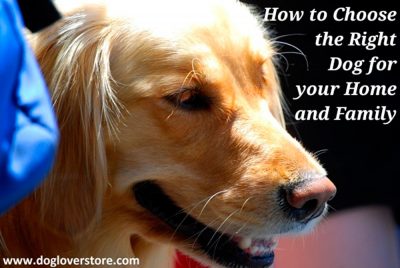How to Choose the Right Dog for your Home and Family
It’s common for families to go to a shelter and adopt a pup based on their cuteness, especially if children are helping decide. But this decision has a big influence on your family, your home environment, and your future. You may think, “we are just adopting a dog”, right? But what if your child has an allergy, or you don’t have a fenced in yard, or you want to make travel plans? Your dog can have a big influence on many aspects of life. There are several factors you need to consider when choosing the right dog. You should consider your current living environment and the status of your family, including finances and commitment to the new addition to your family. The following is a checklist of factors you should consider:
- Rural, Suburban, or Urban living
- Rural areas give active dogs, such as Whippets, Pomeranians, and Affenpinschers, freedom to play and exercise. Rural areas typically have large grassy fields, hiking or walking trails, and ponds or rivers, which are all great spots to take your dog. If your energetic dog is under-exercised, they may turn their excitement into negative energy and start chewing your couch or going through the garbage.
- Suburban areas can be suitable for an active dog depending on the activity level and the size of living space. Suburban areas typically have a mix of outdoor living space along with housing and business developments. If the dog breed you are interested in is somewhat active then a small backyard may provide enough space for your dog to burn energy. If the breed you are interested in has a high level of activeness then you may need to consider another dog or find a park where you and your dog can go to play and run.
- Urban areas, or a city setting, are suitable for dogs with a low level of activeness, such as Yorkies, Papillons, and Shih Tzus. Dog breeds with a high level of activeness may not find this type of living environment suitable if they are not provided with a large area to exude their energy. Many cities have dog-friendly parks, but you must also consider your amount of living space. A large dog in a small studio apartment might lead to cramped quarters.
- Climate conditions
- Hot climates are not suitable for dogs with a thick coat, such as Komondors, Kerry Blue Terriers, Bearded Collies, and Malamutes. Chihuahuas, Italian Greyhounds, and Labradors do just fine in warm or hot weather since their coats are not thick and heavy. You may be able to groom your dog’s coat to accommodate for high temperatures but your dog was purposely bred to have the type of coat they do. Instead, focus more on choosing the right dog for where you live. *Insert* Check out our article on how to prevent and treat dehydration in dogs.
- Cold climates are not suitable for dogs with coats that are not made to protect them from harsh weather, such as American Foxhounds, American Water Spaniels, and Chinese Crested Dogs. Yes, these dogs will be able to live in cold climates of course, but you must be sure not to keep them out for too long or they may get frostbite or hypothermia. Great Pyrenees, Chow Chows, and Bernese Mountain Dogs have coats suitable for cold weather. These types of dogs have coats that actually absorb heat, which insulates them and makes them too hot so they love cold weather.
- Training
- There are a handful of difficult to moderately difficult dogs to train, such as Sealyham Terriers, Pugs, and Irish Setters. Pomeranians can also be difficult to train, as we realized through our own experience when we got our first dog back in 2006. Ease of training is often overlooked but it is one of the most important factors when considering a dog. If you do not have the time, patience, or will to train your dog, you may regret your decision. You could potentially be faced with a dog urinating in the house, barking at every movement outside, and scratching at your leg under the table during dinner. All of these scenarios can create aggravating and undesirable situations, which could eventually, and unfortunately, lead to neglect. Neglecting your dog, whether you are aware of it or not, actually creates even more issues.
- There are a handful of dogs that are easy to moderately easy to train, such as Border Collies, Poodles, and Bichon Frises. Border Collies are arguably thought to be the smartest dog in the world. They are known to be able to learn hundreds and hundreds of commands, whereas the average dog is limited to under 100 commands. Border Collies are beautiful, medium-to-large sized dogs and Bichon Frises are adorable, small dogs, so you can take your pick! Also, Poodles come in both miniature and standard sizes, so you have options here too!
- Grooming
- Many dogs require a high amount of coat care, like Lhasa Apsos, Pekingeses, and Pulis. If you decide on a breed that requires a high amount of care and you are not committed to grooming, you may end up with an uncomfortable dog that has a knotted coat, sharp nails, stinky odors, and fur in unwanted places of your home. With some dogs, like Lhasa Apsos and Shih Tzus, it is common to give them “puppy cuts” or “sport cuts”, which may require more regular visits to the groomer, but it also allows for a shorter coat that requires less brushing. Regular visits to the groomer will help maintain your dog’s shorter cut, just like humans going to the hair salon! Beagles, Basset Hounds, and Boston Terriers require a low level of coat care, but this does not mean they do not shed. It simply means, they require less regular trips to the groomer and less brushing.
- Allergies
- Be aware that some breeds can cause members of your family to have allergic reactions. Some people react to dog hair and some react to saliva. You may want to consider a low-shedding dog, like a Scottish Terrier, Westie, or Border Terrier so you don’t find hair in unexpected places (like when you are napping on the couch!) that may cause an allergic reaction. Dogs can also have reactions to their surroundings. Tree pollens can cause watery eyes and itchy skin. If you are not prepared for extra veterinarian costs then you may want to avoid breeds that are more disposed to these allergies, including but not limited to Schnauzers, Boston Terriers, Boxers, and Irish Setters.
- Feeding Requirements and Size
- When choosing your breed, you may also want to consider the size of the dog which coincides with their feeding requirements. Larger dogs often require larger and more frequent meals throughout the day, which can become costly. Great Danes, Mastiffs, and Rottweilers require a large amount of feeding. If you are not prepared for these expenses, Cairn Terriers, Brittanys, and Corgis may be more suitable.
- Sociableness
- How your dog interacts with other dogs and visitors should be considered. Do you want to tote your dog around wherever you go? Do you have frequent visitors in your home that may be considered a stranger to your dog? Do you have gatherings at your home with a lot of guests? Do you travel a lot? If so, a dog with a high level of sociableness should be considered. Golden Retrievers, Dachshunds, and Saint Bernards are sociable dog breeds. These breeds, and many others, may not cause any ruckus when you welcome guests into your home. They may also not be fearful when you drop them at the dog sitter while you traveling. Dogs with natural temperaments to be protective and fearless may be unsociable, although most of the time these breeds can be trained to be moderately sociable. Chihuahuas, Rottweilers, Basenjis are considered to be unsociable in the canine world.
- Dogs and Children
- Having infants or small children in the home adds another factor that should be considered when selecting your dog breed. Breeds that are part of the Toy category are dogs that you may want to avoid because they can be territorial. The last thing you want is for your child to get hurt and have an unfavorable memory of an interaction with your pup. Toy dogs are also known to be “yappers”, which may disrupt a sleeping child. Although some large breed dogs may be considered sociable, they must be well trained to make sure the dog is careful around the baby. Bulldogs, Beagles, and Keeshond are great choices when there are young children in the home. They are small to medium sized dogs, they don’t make much noise, and they are great around children.
- Life Expectancy
- If you and your family become easily attached or are looking for a dog to become a part of the family, you will want to consider the life span of your future dog so you don’t encounter any unexpected or early deaths. Curly-Coated Retrievers, Bernese Mountain Dogs, and Irish Wolfhounds are known to have the shortest life expectancies while Border Terriers, American Eskimos, Clumber Spaniels and Malteses have a long life expectancy. Check out our article on how you and your family can cope with the death of your dog.
- Diseases and Sicknesses
- Dogs can get many diseases and infections which include, viral, bacterial, fungal, and protozoal. Large dogs, such as Great Danes and Doberman Pinschers are prone to heart diseases. Small dogs, such as Toy Poodles and Miniature Schnauzers can be prone to gastrointestinal diseases. If your dog gets sick, you must be prepared for any veterinarian costs that may arise. Although there are many pet insurance policies now available, many families don’t have them, so your dog’s life may be costly, but priceless. Be sure to research before choosing your dog breed to see what kind of sicknesses your dog can get and how to avoid and prevent them.
To find out more information about the dog breed you are interested in, please visit: http://www.dogluvers.com/
John Mattar
Kimberly Alves
September 14, 2010

Kim is the co-owner of DogLoverStore with her husband, John. She earned her BS in operations management at the University of Massachusetts Dartmouth. She enjoys walking in nature, gardening in the sun, eating sour candy, going on drives, yoga, and reading.



Leave a Reply